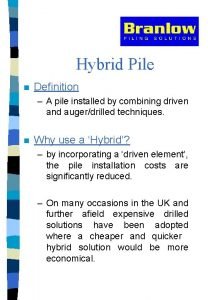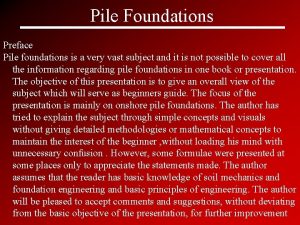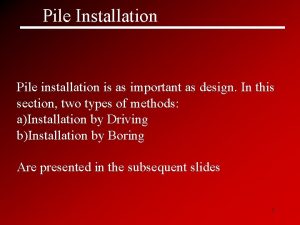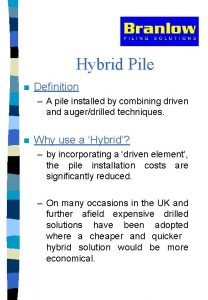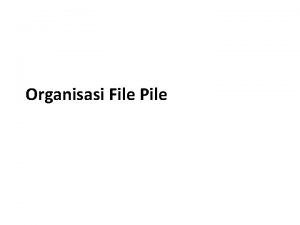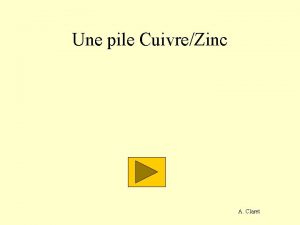Pile The Technique Pile Technique Document Copyright C















- Slides: 15

Pile – The Technique **************************************** Pile Technique Document. Copyright (C) 1999 -2005 Pile Systems Inc, written by Miriam Bedoni. This document belongs to free software; you can redistribute it and/or modify it under the terms of the GNU General Public License Version 2 as published by the Free Software Foundation. **************************************** Pile is a system of mapping connections defined in logical address space and of converting the logical to and from physical address space. Pile’s logic of mapping and efficiency of conversion allows to represent data as connections instead of symbols and thus to compute relations instead of data.

The Pile Logic of Mapping Connections Let‘s leave the conversion for a moment, and focus on logic and implementation of the mapping first. Pile mapping integrates some – at least two – hierarchical structures (trees) by any Object.

The Pile Object Any Pile Object, therefor, not only connects between parent and children, as usual in a tree structure, but provides an additional connection between its two parents and/or Tv‘s, each of which belonging to one or more different hierarchical structures (trees), and thereby integrates two or more such trees. The tool, by which this integration is done, is the Combinative Pointer, short: Cp, where any Pile Object is defined by its two parents via two such Cp‘s and optionally holds as a property a third such Combinative Pointer, which enables the Object to function itself as a parent.

The two Manners Before we continue, we will do a side step here, to introduce some terminology, which is specific to and ( as we found ) necessary for talking about Pile. Since any Object in Pile is defined by two distinct connections to and from its two Parents, we introduce here the term Manner. Any Pile Object is connected in two Manners. We call one Manner the Associative Manner, denoted here by the green arrow, and the other Manner the Normative Manner denoted here by the blue triangel. Therefor, to fully define a Pile Object, we have to define 1) its Associative Parent, short Ap 2) its Normative Parent, short Np.

The three Equations The Cp defined by the Associative Parent of each Object we call Cp 0, the Cp defined by the Normative Parent of each Object we call Cp 1, the Cp defining the parenthood of each Object we call Cp 2. The Unique Identifier of each Object is defined by an ordered set of its Cp 0 and its Cp 1, so that the Cp‘s are related as follows: Cp 0( Object ) = Cp 2( Ap(Object ) ) Cp 1( Object ) = Cp 2( Np(Object ) ) Ui ( Object ) = { Cp 0(Object ), Cp 1(Object ) } The connections between a child and its two parents, between a parent and its children of both Manners, as well as the connection between the two parents of an Object, are implemented by those three equations.

The Object as two Nodes (I) Talking in terms of trees, the Object represents two separate nodes, which are integrated by the Ui and the Cp 2 of the Object. Any node in a tree usually fulfills two functions; it is targeted to be pointed by its parent, and also it points to its own children. A node is: Target (pointed by its parent) Pointer (pointing to its children)

The Object as two Nodes (II) Pile Objects, as well, fulfill those two functions, but, since having two parents, are twice functioning as target. A Pile Object: Target Cp 0 The Ui Cp 1 Target (pointed by its Associative Parent) Normative Parent) Cp 2 Each target element is defined by the connection from/to the parent of one of the two nodes a Pile Object consists of, and only by both target elements together the Object is defined.

The Object as two Nodes (III) The second function of both nodes a Pile Object consists of, pointing to its children, is fulfilled by the Cp 2 of the Object for both nodes together, and therefor integrates them and therefor integrates also all trees defining each of the two parents so far. Target Cp 0 Ui The Associative Node of an Object Pointer Cp 1 Target The Normative Node of an Object Cp 2 (pointing to its Associative and its Normative children)

The Object as Parent In two Manners The Object as parent is not able to distinguish between its Associative Children (Ac) and its Normative Children (Nc). The definition of the Manner is done only by the position given to the value of the (parent‘s) pointing Cp 2 in the child‘s Ui, where the more significant position is denoted as Cp 0, so that the pointing object becomes the Associative Parent, and the less significant position is denoted as Cp 1, so that the pointing object becomes the Normative Parent of the child. The Ui = Cp 0 = Cp 2(Ap) Cp 1 = Cp 2(Np)

The Object as Not_Adult The equivalent to a leave, as the last node at the bottom, in the anology of a tree structure, in Pile is a not_Adult Object. Such Object does not hold a Cp 2 and therefor is not able to define children in either Manner. Target The Associative Node of a not_Adult Object Cp 0 Ui Cp 1 Target The Normative Node of a not_Adult Object As soon as a Cp 2 is assigned to an Object, it is defined to be an Adult Object, whether it defines any children or not (yet). As soon as its Cp 2 is assigned to the Cp 0 and/or the Cp 1 of one or more new Object/s being created, it functions as Ap and/or Np, always supposed a complementing other parent.

Roots I A Pile Structure contains at least two, but, to gain some usefullness, usually more than two, nodes being roots. Since any Pile Object consists of two nodes in the two different Manners, its node in one Manner can be a root, and its node in the other Manner can be a child, or both of its nodes can be roots, in which case the Object is called a System Definer and, then, functions as ( one of ) the beginning/s of the system. The Cp 0 of an Associative Root (Ar), respective the Cp 1 of a Normative Root (Nr), respective the Cp 0 and the Cp 1 of a System Definer (Sd), then, is not a target being pointed by its parent, but, instead, is representing an input value being a Terminal Value (Tv).

Roots II Besides this different, roots in Pile function as any other Object does, so that, for talking about roots, ‘parent‘ is to be replaced by ‘Tv‘, so then the definitions are holding for roots as well. System Definer (Sd) being a root in both Manners: Representing a Cp 0 Terminal Value Ui Cp 1 Representing a Terminal Value Cp 2 The Ui(Sd) = Cp 0 = Tv Cp 1 = Tv

Normative Roots Normative Root (Nr) being an Associative Child: Target Cp 0 Ui (pointed by its Cp 1 Representing a Terminal Value Associative Parent) Cp 2 The Ui(Nr) = Cp 0 = Cp 2(Ap) Cp 1 = Tv

Associative Roots Associative Root (Ar) being a Normative Child: Representing a Cp 0 Terminal Value Ui Cp 1 Target (pointed by its Normative Parent) Cp 2 The Ui(Ar) = Cp 0 = Tv Cp 1 = Cp 2(Np)

N 1 A 1 Trees: A 2 A 3 A 4 A 5 Sd 2 2 P I P L I L E E PI Tv “ 2“ Tv “P“ “I“ “L“ “E“ LE PILE Pile. Monkeys
 Document
Document Hươu thường đẻ mỗi lứa mấy con
Hươu thường đẻ mỗi lứa mấy con Diễn thế sinh thái là
Diễn thế sinh thái là đại từ thay thế
đại từ thay thế Thế nào là hệ số cao nhất
Thế nào là hệ số cao nhất Vẽ hình chiếu vuông góc của vật thể sau
Vẽ hình chiếu vuông góc của vật thể sau Thế nào là mạng điện lắp đặt kiểu nổi
Thế nào là mạng điện lắp đặt kiểu nổi Mật thư tọa độ 5x5
Mật thư tọa độ 5x5 Lời thề hippocrates
Lời thề hippocrates Vẽ hình chiếu đứng bằng cạnh của vật thể
Vẽ hình chiếu đứng bằng cạnh của vật thể Thang điểm glasgow
Thang điểm glasgow Quá trình desamine hóa có thể tạo ra
Quá trình desamine hóa có thể tạo ra Sự nuôi và dạy con của hổ
Sự nuôi và dạy con của hổ Các châu lục và đại dương trên thế giới
Các châu lục và đại dương trên thế giới Các loại đột biến cấu trúc nhiễm sắc thể
Các loại đột biến cấu trúc nhiễm sắc thể

















